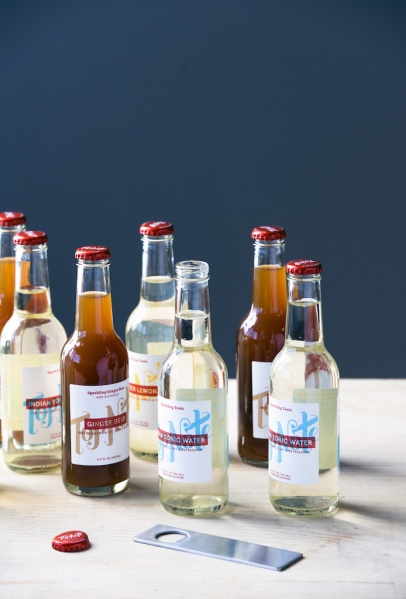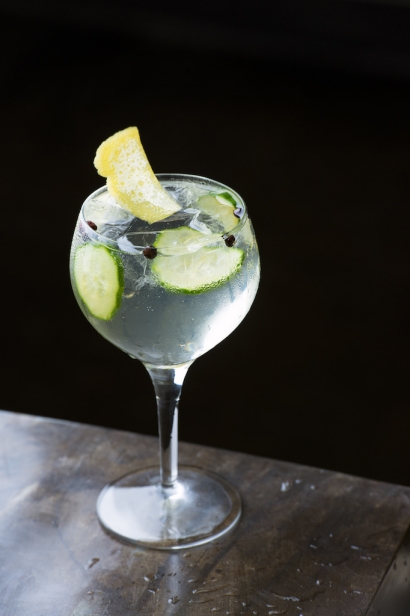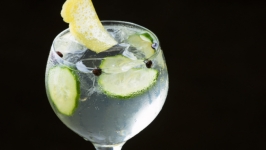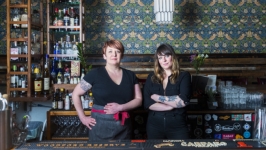Seeking the Top Notes
Mary Pellettieri’s flavor lab spreads out into one of the “offices” of the Lincoln Warehouse, overlooking the Milwaukee River. A tiny sales office is tucked away from the main area, kitty corner to the industrial kitchen, with palettes and boxes stacked against the wall and in the middle of the floor.
But this sunlit space is evolving, just as Pellettieri’s line of tonics and upscale mixers, Top Note, are growing and expanding. Pellettieri, who is co-founder and president of La Pavia Beverages, started her company in 2014 with a line of tonic syrups, which could be mixed with seltzer and added to cocktails. Today, she does all of her flavor innovations and experiments in this flavor lab, while her ready-to-drink artisan mixers and soft drinks are bottled elsewhere.
She shares her kitchen with John Ferrell, owner of Philocoffia, who is already testing and producing his coffee elixirs here, and this summer, it’s being remodeled and outfitted to suit Karen Gill, owner and chef of the Focused Fork, with the vision that the entire space of the flavor lab can be rented out for events. “We can do pop-ups here,” Pellettieri says, as she sets up a bar on the kitchen island.
Pellettieri lines up her gins and tonics, and she sets out a carafe of ice, along with bitters, a jar of juniper berries, cucumbers, and various citrus fruits. In Spain, Pellettieri explains, the making of gin and tonics has become an art. Different gins are paired with different tonics, and various garnishes and bitters are added to bring out the different aromas and flavors of both the different gins and tonics. “It’s almost like an herbal sangria,” she says. “It becomes this very beautiful and refreshing drink.”
To a large goblet, Pellettieri adds a measure (1 ½ to 2 oz.) of Twisted Path gin. She douses it with a couple of shakes of angostura bitters, twists a lemon peel over it, and adds ice cubes. She pours Indian Tonic (3 to 4 oz.) on top, drops in a few cucumber slices and juniper berries, and then stirs the whole drink together so that it’s lightly blushed and bubbling. Leaning forward to drink, different aromas waft and blend, with citrus mingling with juniper and cucumber. “As the ice melts, it’s becoming a different drink every time you sip it,” Pellettieri says.
“It’s kitchen chemistry in a glass,” says Douglas Fox, an investor and an advisor to Top Note.
Fox says that he was impressed with Pellettieri’s view of how craft soft drinks and mixers, specifically tonics, are where craft beer was 10 years ago. “I believe in Mary, and I believe in the product,” he says. “She has a great palate, and she has a great vision.”
The main principle that guides Pellettieri is to build a better tonic, or rather, tonics. If you’re going to drink a good gin or a stellar vodka, she says, then you might as well spring for a better bittering agent. And tonics, specifically, don’t have to sing the one note bitters of the cinchona tree bark or quinine. But most tonics, even smaller batch versions, rely almost solely on quinine.
“There’s a whole spectrum of bitters,” Pellettieri says. “If bitters were music, quinine, which is very citrusy, would be the highest of the high notes, but bitters can also be very earthy, soft and clean like gentian root. Even hops fall in the bitter spectrum. A brewer knows this stuff and can manipulate it to innovate new (beers). I think we need to innovate in the tonic world.”
Coming from the beer world, Pellettieri approaches tonics the way craft brewers approach ale. After getting a degree in botany from North Carolina State and then getting her masters in occupational and environmental health from the University of Illinois-Chicago, she worked for Goose Island in product development and quality control. “I was the only female at Goose Island,” she says. “I would go to master brewers meetings, and I was the only woman there. There are women around in the business, but you have got to look for them.”
While at Goose Island, she helped 312, Matilda and Sofie beers make their debut. “Those were my girls,” she says. “I cannot take credit for the recipes the brewers came up with, but it was working with them and taking them to market. I was the quality manager.”
MillerCoors hired Pellettieri away to Milwaukee for a senior corporate position, and she always thought she might someday open her own craft brewery, perhaps focusing on the herbal beers she was experimenting with in her spare time. But the more she delved into herbs, bittering agents and tonics, the more her interest shifted. “The soft drink business just seemed more interesting,” she says. “The alcohol-adjacent space seemed like a better plan, and that’s the next place that innovation is going to take place.
“Plus, I had been in beer for over 20 years,” she adds. “A lot had already been done. People are still innovating, but I don’t want to be in a saturated space. It’s much more my personality to strike out somewhere new.”
That’s exactly what she’s done, especially with her award-winning Indian Tonic, which is the only craft tonic to combine quinine with gentian root. Her line of bottled beverages also includes a Bitter Lemon and a Ginger Beer. This spring, restaurants and bars began selling her Grapefruit Sour, Lemon Cuc Sour and Classic Tonic. “I wanted to show I could do a traditional tonic,” she says, of her new classic.
The grapefruit can be mixed with tequila and lime juice for a Paloma cocktail or added to beer for a summer radler. The lemon cuc not only combines lemon and cucumber, but it also adds celery for an additional savory note, lending itself to be used as another gin and vodka mixer or as a sparkling savory note to tomato juice.
By the fall, her line’s latest add-ons will likely be available in large bottles for consumers to purchase at stores. Though Pellettieri initially only distributed Top Note in Wisconsin, she began selling her products in both Chicago and the Twin Cities late last year.
“It’s taking off in Chicago,” Pellettieri says, adding that it’s now in Binny’s Liquor Stores, at Soho House and at influential bars and restaurants like the two-Michelin-starred Oriole.
“What we’re seeing in Chicago is key influencers are discovering it,” Fox says. “A well-known restaurateur tasted it at Soho House, and now, he’s got it in all of his restaurants.”
There are plans to roll out in Washington, D.C., San Francisco, Austin and New Orleans. She also will be headed to New Orleans to attend Tales of the Cocktail this summer.
“Then, we’ll be rocking and rolling,” she says.
“No, you’re already rocking and rolling,” Fox says.
But though Top Note’s volumes are ever-increasing in larger markets, Pellettieri has no plans to move her central operations from the warehouse, sitting on the dividing line between Bay View and Walker’s Point. “It’s nice here in Milwaukee,” she says. “We still do all our innovations here, creating new syrups and flavors. We create all of our formulas in house. We work with botanical extract companies, but we don’t rely on flavor companies as we create it. That makes it a much more authentic process.”
Just within the warehouse, she has collaborated with Twisted Path Distillery, which became her first account to have her tonic on tap, and her tonics and ginger beer are used in a variety of creative cocktails, including the Columbian Mule, in which Twisted Path’s high proof vodka is blended with nitro cold brew, ginger beer and served with a powdered sugar rim.
“I feel like Alice, chasing down different rabbits in different holes,” Pellettieri says. “Being an entrepreneur is challenging.”
But rewarding, and she wouldn’t have it any other way.









